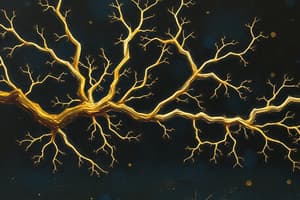Podcast
Questions and Answers
What happens in step 1 of the neuromuscular junction process?
What happens in step 1 of the neuromuscular junction process?
An action potential travels down the axon.
What occurs in step 2 of the neuromuscular junction process?
What occurs in step 2 of the neuromuscular junction process?
Calcium channels open and calcium enters the axon terminal.
What is caused by calcium entering the axon terminal in step 3?
What is caused by calcium entering the axon terminal in step 3?
Calcium entering causes vesicles to release AcH via exocytosis.
In step 4, where does ACh diffuse to?
In step 4, where does ACh diffuse to?
What happens in step 5 regarding sodium channels?
What happens in step 5 regarding sodium channels?
What occurs inside the muscle fiber during step 6?
What occurs inside the muscle fiber during step 6?
Describe step 7 in the neuromuscular junction.
Describe step 7 in the neuromuscular junction.
What happens in step 8 regarding ACh activity?
What happens in step 8 regarding ACh activity?
What is the purpose of the diffusion of acetylcholine as stated in step 8 A.K.A?
What is the purpose of the diffusion of acetylcholine as stated in step 8 A.K.A?
What is the definition of depolarization in muscle fibers?
What is the definition of depolarization in muscle fibers?
Flashcards are hidden until you start studying
Study Notes
Steps of Neuromuscular Junction Transmission
- An action potential travels down the axon, initiating the neuromuscular transmission process.
- Calcium channels in the axon terminal open, allowing calcium ions to enter and trigger subsequent reactions.
- The influx of calcium ions causes synaptic vesicles to release acetylcholine (ACh) into the synaptic cleft through the process of exocytosis.
- ACh diffuses across the synaptic cleft and binds to acetylcholine receptors located on the junctional folds of the motor end plate.
- When ACh binds to its receptors, sodium channels open, permitting sodium ions to cross the sarcolemma, which leads to muscle fiber excitation.
- The entry of sodium ions results in depolarization, where the inside of the muscle fiber becomes more positive.
- Following the depolarization, an action potential is generated and travels across the sarcolemma, further stimulating muscle contraction.
- The activity of ACh is terminated by the enzyme acetylcholinesterase (AChE), which breaks ACh into acetyl and choline, preventing further activation of ACh receptors.
- Acetylcholine can also diffuse away from the synaptic cleft, contributing to its termination.
Studying That Suits You
Use AI to generate personalized quizzes and flashcards to suit your learning preferences.




